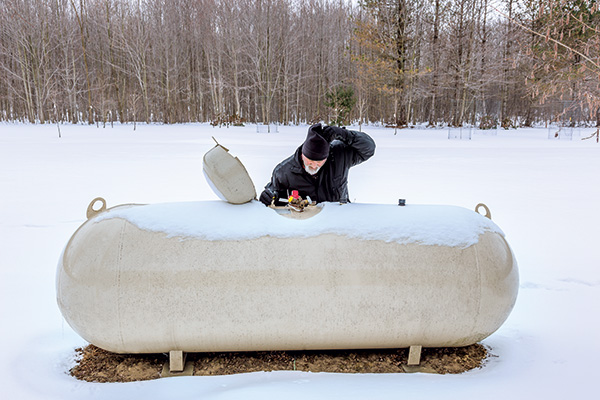Prevent water from freezing in your propane

Adding methanol to a propane tank can help control freeze-ups. Photo: Mr-Tobin/iStock / Getty Images Plus/Getty Images
This is the time of year when the dreaded call comes that a customer has no heat.
I remembered the transport driver complaining that it took a long time to off-load the transport on the last delivery at the bulk plant. I get into the bobtail assuming that the customer is out of gas and go to the customer’s home to find the regulator is covered in ice, aggravated at the realization that I made the trip in the bobtail for a regulator problem.
I assure the customer that I will be back to fix the issue and go back to the office to get a new regulator. Now that it is dark and cold, I replace the regulator and pigtail, complete the leak test on the system, purge the air and place the furnace back into operation.
The customer is now happy, and I collect my stuff and go home. No sooner had I gotten home than the phone rings again. It is the same customer, extremely upset that again they have no heat. Now I am searching for answers. It was a brand-new regulator. How could that happen? Did we receive a bad bunch of regulators?
We all know how that story ends – a very long night and, something unique about regulator freeze-ups, they typically come in bunches on the coldest, darkest nights.
Finding solutions
We have all been exposed to this type of situation, a reoccurring problem we are trying to address. The challenge is to find the root cause, which, in this case, was water in the gas, which caused the regulator to freeze up.
I could have asked the customer more questions about the situation. Recognizing telltale indicators of a regulator freeze-up, such as ice in the loading hoses of transports or bobtails, could have saved a lot of time and aggravation. I should have questioned the transport driver about the unloading issue. Even though the temperature was below 35 degrees F that day, I did not inquire – or even know – about conducting a freeze valve test. I needed to focus on some precautionary steps to ensure the quality of the propane.
Methanol treatment
There is a lot of information in the industry about how to prevent regulator freeze-ups – from ensuring the first-stage regulator is mounted in a way that will allow water to drain back into the tank to using a heat source to keep the regulator warm. A November 2007 report by the Propane Education & Research Council contains the best information.
The report details how to add methanol to control freeze-ups. Adding methanol has long been a practice in the industry, but this report explains when to add it, how much to add, and that just adding methanol as a precautionary measure is not the answer. Everyone should review this report from time to time to take a proactive approach to quality control and to minimize the risk of excess water. You can find the report and more information at propane.com by searching methanol.
As a quick guideline, add methanol when:
- Outside temperatures are expected to be below 35 degrees F and
- Product has failed a freeze valve test; or
- Indication of the presence of water (ice) is known.
- There are no known fuel issues but outside temperatures are expected to be below 20 degrees F or a large drop in outside temperature is expected.
It is not recommended to treat if:
- The fuel has already been treated; or
- The outside temperature is not expected to fall below 40 degrees F.
Randy Warner is the product safety manager for Cavagna North America. He can be reached at randywarner@us.cavagnagroup.com.
NOTE: The opinions and viewpoints expressed herein are solely the author’s and should in no way be interpreted as those of LP Gas magazine or any of its staff members.
















